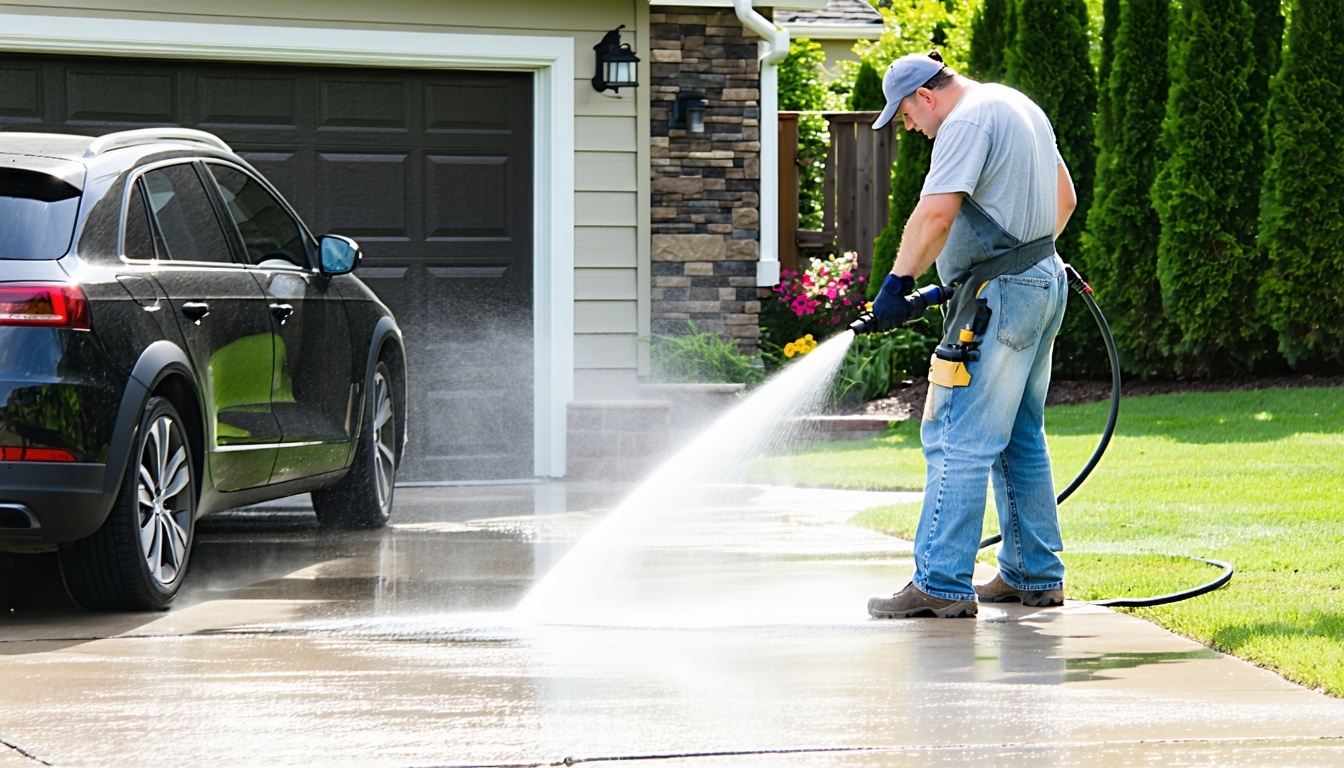How to Price Pressure Washing Jobs: Residential & Commercial Clients
The pressure washing industry is characterized by a diverse clientele and varied project requirements that demand a flexible and competitive pricing strategy.
So you've started a pressure washing business, now what?
Let's talk about pricing pressure washing jobs.
Residential and commercial clients often have unique needs and budget constraints, making a one-size-fits-all pricing model ineffective or restrictive. Instead, a nuanced approach tailored to different types of jobs is essential.
This guide provides specific and actionable insights into setting appropriate pressure washing prices for your business. Let's explore how to price pressure washing jobs, while striking the perfect balance between being competitively priced and profitably sustainable.
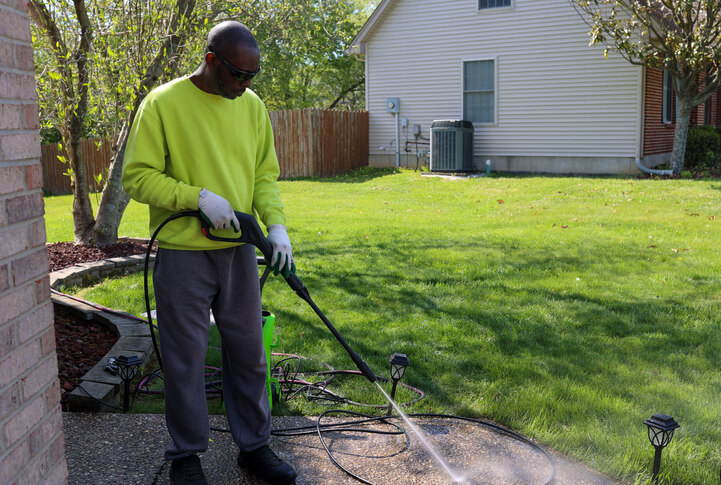
5 Power Washing Pricing Factors to Consider
Determining the right price for pressure washing services involves several critical factors. Each of them plays a pivotal role in shaping a pricing strategy that both reflects the value of your work and best aligns with current market expectations. Let’s examine these factors in detail:
1. Size of the Project
When it comes to pricing pressure washing jobs, size matters. Larger projects generally mean lower costs per square foot thanks to economies of scale. Contractors can spread their expenses over more areas.
On the other hand, smaller jobs which cover less area cost more per square foot because contractors still need to cover setup and mobilization expenses. So, whether you're taking on a massive renovation or a smaller project, keep in mind that the scale of the job can greatly impact the pricing per square foot.
2. Type of Surface
The surface material determines the technique and care required for a particular pressure washing job. Delicate surfaces like wood or certain types of siding require a gentler approach, potentially involving more specialized equipment or cleaning solutions that drive up the cost.
3. Location
Your service area and reach is another important factor. Urban settings might offer proximity and convenience, potentially reducing travel costs. In contrast, remote locations could mean additional travel expenses and time, which must factor into your pricing. For example, tolls, gas, and time to and from the job impact your availability for your next job or return to base.
4. Accessibility
The ease of access to a project area is also crucial. Hard-to-reach places such as high exteriors or obstructed surfaces require additional labor, safety measures, and possibly special equipment that increase the job's cost. This can also increase the time to set up and break down from a job.
5. Equipment Used
Finally, the type of equipment employed affects pricing. High-end machinery may offer quicker and more effective cleaning, but the investment in such equipment needs to be recouped through pricing. Less advanced equipment might lower initial costs while increasing labor time and overall project duration. Time is money.
Estimate Materials and Overhead Costs
How to estimate pressure washing jobs requires clear understanding of the initial investment and ongoing overhead costs is key to managing a pressure-washing business. That informs your pricing strategy and overall financial planning.
Here’s what you must consider:
Initial Costs of Tools and Equipment
Starting a pressure washing business requires an investment in quality equipment. That includes pressure washers, nozzles, hoses, cleaning solutions, and safety gear. The choice of equipment significantly affects both the quality of service and operational efficiency.
For instance, depending on its specifications and capabilities, commercial-grade pressure washers range from $1,000 to $3,000.
And dont forget the tools you need to run your business like office equipment, computers and pressure washing software.
Buying vs. Renting Equipment
- Buying: The advantage of buying your equipment is clear ownership and long-term cost savings. It's a substantial upfront investment but pays off over time, especially if you have a steady stream of customers. Owning equipment also means you can customize it to your specific business needs. It’s worth mentioning that you can even buy used pressure washing equipment. Just because it’s used, doesn’t mean it’s broken or less valuable.
- Renting: Renting is a viable option for those starting or handling occasional, specialized jobs that require unique equipment. It reduces upfront costs and transfers the maintenance responsibilities to the rental company. Bear in mind, though, that frequent renting can become more expensive and limit your job flexibility.
- Storage Space Costs: Securing a place to store your equipment and supplies is another factor that creeps into your pricing calculations. Whether it’s a garage space, a storage unit, or a rented facility, you must consider the rental cost, security, and accessibility. The size of your operation and the equipment volume will dictate how much storage space you need and its associated costs.
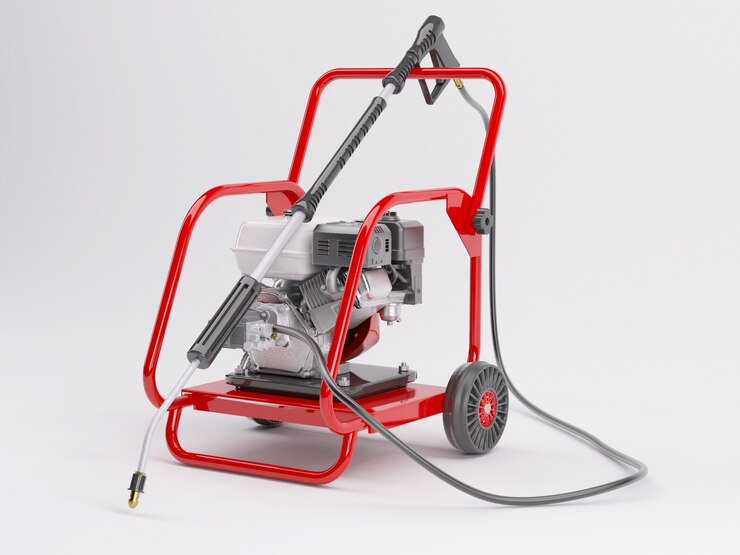
Cost Per Project Size vs Per Cost Per Hour
Pricing strategies in the pressure washing industry often revolve around two main models: cost per project size (typically square footage) and per-hour rates. Each method has its benefits and drawbacks, and understanding them can help you determine the best approach for your business.
Pricing Per Square Footage
- Benefits: This model offers clear and straightforward pricing for clients. It's based on the size of the area to be cleaned and makes it easy for you to calculate. This model works out to be more cost-effective on the client side when larger projects are involved.
- Drawbacks: The challenge lies in accurately assessing the size and complexity of the job. Unexpected complications or filthy areas can require more time and effort than the size alone suggests.
- Industry Standard Rates: Rates per square foot can vary, typically from $0.08 to $0.35, depending on surface type and job complexity.
Hourly Rate Pricing
- Benefits: Hourly pricing benefits jobs with unclear scope or tasks likely to involve varying levels of dirt or grime. It adequately compensates the time and effort put into the job.
- Drawbacks: The main downside is potential uncertainty for the client regarding the final cost, especially if the job takes longer than expected.
- Industry Standard Rates: Hourly rates in the pressure washing industry can range from $50 to $150 per hour. The final rate is influenced by regional cost differences and the level of expertise required.
Consider the nature of your typical projects when deciding which pricing model to apply to a project. Square footage pricing works well for straightforward, predictable jobs, while hourly rates may be better for projects with uncertain scopes or those requiring specialized cleaning.
Add Your Profit Markup
Determining the correct profit markup is critical to ensuring the financial health of your pressure-washing business. It's about finding the spot where your prices are competitive yet still provide a sustainable margin.
Check out this real life example from Total Restoration Team, and learn how they've managed to generate half a million dollars in sales.
Calculating a Profit Markup
Begin by calculating your total costs, including materials, labor, overheads, and any other expenses related to the job. Once you have this figure, decide on a percentage that you aim to earn as profit. A common approach is to add a 15-30% markup on top of your costs, depending on your business goals and market conditions.
For instance, if your total job cost is $100 and you decide on a 20% markup, you would charge $120 for the service. The $20 on top is your profit.
Balancing Competitive Pricing with Sustainable Profit Margins
Research is critical here Understand what your competitors are charging and how your services compare. You may justify a higher markup if your services offer additional value, such as superior technology or exceptional customer service.
Always keep in mind the perceived value of your service to the customer. Overpricing can drive customers away while underpricing may lead to unsustainable profit margins.
Adjust your markup based on feedback and market response. If you’re consistently winning a lot of business but not seeing much profit, it might be time to increase your rates. Conversely, a reassessment might be needed if you lose out on jobs due to pricing.
Become the Top Business in Your Area
Learn the proven strategies of top-rated businesses who've skyrocketed their trust, credibility, and sales.
Get the Blueprint.png)
Pressure Washing Cost Calculator
Providing accurate job estimates in any industry can be complex, given the multiple variables and requirements involved.
A pressure washing cost calculator is a digital tool that helps estimate job prices by considering multiple variables. These variables typically include the size of the project, type of surface, level of dirt or grime, and local labor costs, among others.
The calculator considers the different pricing models, such as per square foot or hourly rates, and adjusts the final estimate accordingly. It can also factor in material and overhead costs. For complex projects, the calculator can include additional costs like equipment rental or extra labor needed for hard-to-reach areas.
Including a cost calculator on your business website can be a significant value addition. It offers potential clients an immediate estimation of project costs, enhancing user engagement and trust.
Real-World Example of a Pressure Washing Cost Breakdown
Let's consider a real-world example to provide a practical understanding of how pressure washing costs are determined. Imagine a residential pressure washing job for a 2,000-square-foot home with vinyl siding, including a driveway and a small deck area.
- Project Size and Scope:
- House (vinyl siding): 2,000 sq. ft.
- Driveway: 600 sq. ft.
- Deck: 200 sq. ft.
- Cost Calculation:
- House cleaning: At an average rate of $0.20 per sq. ft., the cost for the house would be 2,000 x $0.20 = $400.
- Driveway cleaning: Typically charged at $0.30 per sq. ft., leading to 600 x $0.30 = $180.
- Deck cleaning: This might be a bit higher due to the care needed, say $0.35 per sq. ft., making it 200 x $0.35 = $70.
- Additional Factors:
- Accessibility: If the house has areas that are hard to reach and require additional time or special equipment, this could add, for instance, an additional $50 to the cost.
- Material and overhead costs: For equipment wear-and-tear, cleaning solutions, and water usage, let’s add $60 to the project.
- Total Estimated Cost:
- Adding these figures together, the total estimated cost for this job would be $400 (house) + $180 (driveway) + $70 (deck) + $50 (accessibility) + $60 (materials and overhead) = $760.
- Adding these figures together, the total estimated cost for this job would be $400 (house) + $180 (driveway) + $70 (deck) + $50 (accessibility) + $60 (materials and overhead) = $760.
- Profit Markup:
- Applying a 20% profit markup on the total cost: $760 + (20% of $760) = $760 + $152 = $912.
Therefore, the final price quoted to the customer for this comprehensive pressure washing job would be approximately $912.
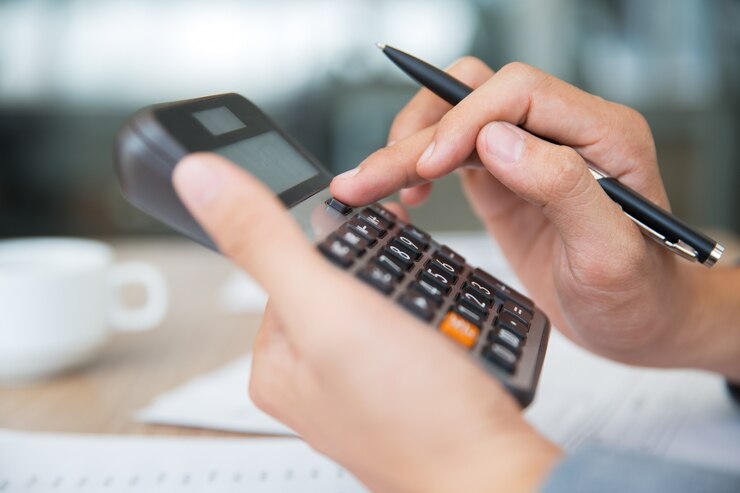
Average Cost of Pressure Washing Residential Buildings
Let's dive into the world of pressure washing residential buildings. The thing is, pricing for this service can be all over the map, and there are a bunch of factors that come into play. Knowing the average costs and what drives those prices can really help both the offering of the service and the homeowners looking to spruce up their place.
It's all about setting and managing expectations, so let's break it down, shall we?
Average Pricing Range
The average cost of pressure washing for residential properties can vary significantly. The typical range is between $170 to $360 for an entire house.
This final price is based on regional labor costs, home size, and job scope differences. Smaller homes may fall at the lower end of this range, while larger homes or more extensive projects will be at the higher end.
Factors Influencing Cost in Residential Settings
- Size and Layout of the Home: Larger homes and businesses or those with complex layouts often cost more due to the increased surface area and the time it takes to clean.
- Type of Surface: Different materials like vinyl, brick, or wood require different cleaning techniques, solutions, and pressures, which affects the cost.
- Level of Dirt and Grime: Heavily soiled areas may need pre-treatment or additional cleaning efforts that impact the final price.
- Accessibility: Hard-to-reach areas, such as high exteriors or obstructed surfaces, might require special equipment or additional labor.
- Local Labor Rates: Local market conditions and labor rates can also influence prices.
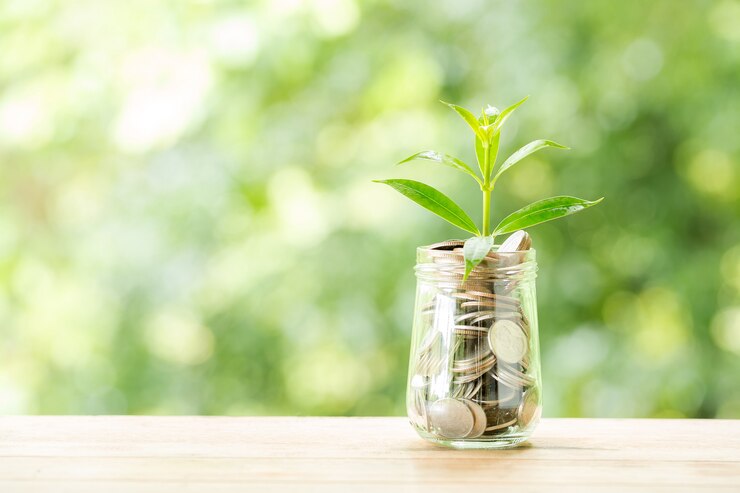
Average Cost of Pressure Washing Commercial Buildings
When it comes to pricing commercial pressure washing projects, it's a whole different ball game compared to residential jobs. Commercial buildings bring a whole new set of considerations to the table. The scale, complexity, and specific requirements of these structures demand a tailored approach to pricing.
It's not just about blasting away dirt – it's about understanding the unique needs of each commercial property and providing a customized solution. So, when it comes to commercial pressure washing, it's all about taking those factors into account to ensure a fair and accurate price for the job.
Cost Range for Commercial Projects
Commercial pressure washing prices can vary more widely than residential projects due to the diverse nature of commercial properties. Generally, the cost can range from a few hundred dollars for smaller buildings or specific areas to several thousand for larger complexes or extensive cleaning projects.
The price is often quoted based on the square footage, with rates ranging from approximately $0.08 to $0.35 per square foot, but these figures can fluctuate based on various factors.
Factors Affecting Pricing in Commercial Settings
- Scale of the Project: Larger buildings or complexes require more time, labor, and resources, which increases the overall cost.
- Complexity of the Job: Commercial properties may have specific cleaning needs, such as removing heavy grime, oil stains, or graffiti, which can add to project complexity and cost.
- Accessibility and Safety Concerns: Taller buildings or those with challenging access points may need additional equipment like lifts or scaffolding. Some states require permits or insurance for scaffolding and lifts on sidewalks.
- Frequency of Service: Regular maintenance contracts might offer a reduced rate per service compared to one-time cleanings.
- Local Market Rates: As with residential services, local market conditions and labor rates will influence pricing.
Picking Your Pricing Strategy
Selecting the right pricing strategy in the pressure washing industry is vital for your business's success. This decision should align with your business type, market conditions, and your range of services.
Understanding Different Pricing Strategies
Cost-Plus Pricing: This involves adding a fixed percentage markup to the service cost. It's straightforward, but the customers may not always agree with the markup and end up bargaining.
Market-Oriented Pricing: Pricing is based on competitor rates and what the market can bear. This strategy requires thorough market research and can be effective in highly competitive areas.
Value-Based Pricing: Setting prices based on the perceived value of your services to the customer. This can often lead to higher profits but requires understanding your service's unique benefits.
Choosing the Right Strategy
- Assess Your Business Type and Objectives: Are you targeting high-end clients or offering budget services? Your strategy should align with your business goals and the type of customers you want to attract.
- Analyze Market Conditions: Understanding your local market, including competitor pricing and customer expectations, is crucial. You may need to adjust your strategy to remain competitive if you're in a highly competitive area.
- Consider Your Service Range: Do you offer specialized services that can command a higher price? Value-based pricing could be more appropriate. For more standard services, cost-plus or market-oriented pricing might be more suitable.
Elevate Your Pressure Washing Business with Smart Pricing and NiceJob
Now that you've got your pricing figured out, its time to get pressure washing jobs and get the revenue flowing!
Take your business to the next level with NiceJob. Known for enhancing business efficiency and customer engagement, NiceJob offers tools and solutions that align perfectly with your business needs.
Whether it's managing customer reviews, leveraging digital marketing, or optimizing your online presence, we support your growth journey whatever the objective.
Try out our free Business Blueprint today to get started.
Turn Your Reputation into Your Ultimate Sales Tool
Learn how to build trust and attract more customers with our complete guide to reputation marketing.
Read the Guide%20(1)%20(1).png)


%20(1).jpg)
.jpg)
